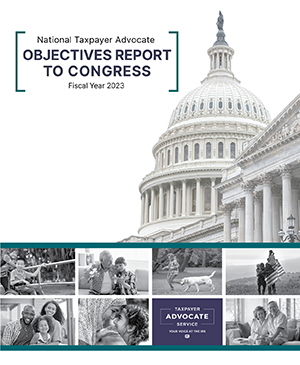

National Taxpayer Advocate Erin M. Collins released her statutorily mandated mid-year report to Congress. The report expresses concern about continuing delays in the processing of paper-filed tax returns and the consequent impact on taxpayer refunds. At the end of May, the agency had a backlog of 21.3 million unprocessed paper tax returns, an increase of 1.3 million over the same time last year.
“The IRS has said it is aiming to crush the backlogged inventory this year, and I hope it succeeds,” Collins wrote. “Unfortunately, at this point the backlog is still crushing the IRS, its employees, and most importantly, taxpayers. As such, the agency is continuing to explore additional processing strategies.”
More than 90 percent of individual income taxpayers e-file their returns, yet last year, about 17 million taxpayers filed their returns on paper. Some choose to file on paper. Some have no choice because they encounter e-filing barriers, such as when they are required to file a tax form or schedule the IRS cannot accept electronically. Before the pandemic, the IRS typically delivered refunds to paper-filers within four to six weeks. Over the past year, refund delays on paper-filed returns have generally exceeded six months, with delays of ten months or more common for many taxpayers.
The report says the IRS has failed to make progress in eliminating its paper backlog because “its pace of processing paper tax returns has not kept up with new receipts.” During the month of May, the IRS processed an average of about 205,000 individual income tax returns (Forms 1040) per week. Its Form 1040 backlog at the end of May stood at 8.2 million, with millions more paper tax returns not yet classified or expected to arrive before the extended filing deadline of October 15. The report says the IRS would have to process well over 500,000 Forms 1040 per week – more than double its current pace – to eliminate the backlog this year.
Forms 1040 are just one component of the paper tax returns processing backlog. Millions of business tax returns and amended tax returns (both individual and business) are also filed on paper. The overall backlog has increased by seven percent over the past year.
Largely because of the likelihood that the IRS will carry a large inventory of unprocessed paper tax returns into the 2023 filing season, Collins issued a Taxpayer Advocate Directive (TAD) in March directing the IRS to implement 2-D barcoding or other scanning technology to automate the transcription of paper tax returns. “Today, the digits on every paper return must be manually keystroked into IRS systems by an employee,” Collins wrote. “In the year 2022, that doesn’t just seem crazy. It is crazy.
The report credits the IRS with taking recent steps to address the backlog but notes “missed opportunities” to have acted earlier. “The IRS’s paper processing delays were evident more than a year ago, and the IRS could have addressed them more aggressively at that time,” Collins wrote. “Had the IRS taken steps a year ago to reassign current employees to processing functions, it could have reduced the inventory backlog carried into this filing season and accelerated the payment of refunds to millions of taxpayers. Had the IRS implemented 2-D barcoding, optical character recognition, or similar technology in time for the 2022 filing season, it could have reduced the need for employees to engage in the highly manual task of transcribing paper tax returns. Had the IRS quickly used some of the $1.5 billion of additional funds provided by the American Rescue Plan Act of 2021 (ARPA), which was enacted 15 months ago, to hire and train additional employees, it could have worked through the backlog, answered more taxpayer telephone calls, and otherwise improved taxpayer service.”
At the end of May 2021, the IRS had an additional 15.8 million returns that had been suspended during processing and required manual review by IRS employees. The suspended returns consisted largely of e-filed returns on which taxpayers claimed Recovery Rebate Credit amounts that differed from the allowable amounts shown on IRS records. As of May 2022, the IRS had reduced the number of suspended returns to 5.4 million. The report credits the IRS with developing procedures to reduce delays among suspended returns, in part by automating the review process. However, e-filed returns suspended during processing did not generally result in extended refund delays. By contrast, unprocessed paper-filed tax returns have resulted in refund delays of six to ten months or longer.
Through May 21, the IRS processed five million taxpayer responses to proposed adjustments. It took an average of 251 days to do so – more than eight months. That is more than triple the processing time of 74 days in fiscal year 2019, the most recent pre-pandemic year. For the over 336,000 taxpayers who could not file their returns or receive their refunds because identity thieves had already filed a return using their identifying information, they now generally must wait at least a year to receive their refunds.
During the 2022 filing season, the IRS received about 73 million telephone calls. Only one out of ten calls reached an IRS employee. Compared with the 2021 filing season, IRS employees answered less than half as many calls, but the percentage of calls answered remained about the same because they also received less than half as many calls. The time the average taxpayer spent waiting on hold rose from 20 minutes to 29 minutes.
As required by law, the Advocate’s report identifies TAS’s key objectives for the upcoming fiscal year. The report describes 14 systemic advocacy objectives, six case advocacy and other business objectives, and three research objectives. Among the objectives the report identifies are:
The National Taxpayer Advocate made 88 administrative recommendations in her 2021 year-end report and then submitted them to the Commissioner for response. The IRS has agreed to implement 61 (or 69 percent) of the recommendations in full or in part. The IRS’s responses are published on the TAS website at https://www.taxpayeradvocate.irs.gov/arc-recommendations-tracker.